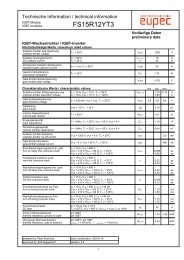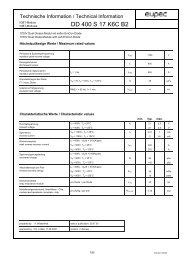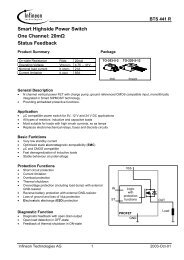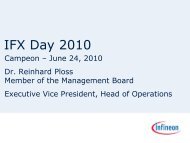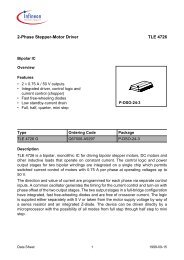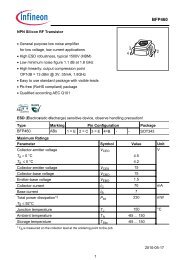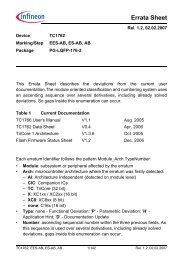TC1765_ds_v12 (TC1765_ds_v12_1202.pdf) - Infineon
TC1765_ds_v12 (TC1765_ds_v12_1202.pdf) - Infineon
TC1765_ds_v12 (TC1765_ds_v12_1202.pdf) - Infineon
- TAGS
- infineon
- www.infineon.com
Create successful ePaper yourself
Turn your PDF publications into a flip-book with our unique Google optimized e-Paper software.
Preliminary<br />
Input/Output DC-Characteristics (cont’d)<br />
VSS = 0 V; TA = -40 °C to +125 °C;<br />
Parameter1) Symbol Limit Values Unit Test Conditions<br />
min. max.<br />
Pin capacitance 10)<br />
(Digital I/O)<br />
C IO CC – 10 pF f = 1 MHz<br />
T A = 25 °C<br />
Class C Pins (V DDOSC = 2.30 to 2.75 V), see Page 68<br />
<strong>TC1765</strong><br />
1) All Class A pins of the <strong>TC1765</strong> are equipped with Low-Noise output drivers, which significantly improve the<br />
device’s EMI performance. These Low-Noise drivers deliver their maximum current only until the respective<br />
target output level is reached. After that the output current is reduced. This results in an increased impedance<br />
of the driver, which attenuates electrical noise from the connected PCB tracks. The current, which is specified<br />
in column “Test Conditions”, is delivered in any case.<br />
2) This specification is not valid for outputs of GPIO lines, which are switched to open drain mode. In open drain<br />
mode the output will float and the voltage results from the external circuitry.<br />
3) Output drivers in high current mode.<br />
4)<br />
Condition for output driver in dynamic current mode & low current mode – guaranteed by design<br />
characterization.<br />
5)<br />
Input characteristics can be switched between TTL and CMOS via register Px_PICON except for dedicated<br />
pins which have CMOS input characteristics.<br />
6) The maximum current can be drawn while the respective signal line remains inactive.<br />
7) The two pull-up/pull-down current test conditions for VOUT cover the curves as shown in Figure 20 and<br />
Figure 21. All pull-up/pull-down currents are given as absolute values.<br />
8) The minimum current must be drawn in order to drive the respective signal line active.<br />
9) In case of Class B pins V DDx = V DD . In case of Class A pins V DDx = V DDP .<br />
10) Guaranteed by design characterization.<br />
11) The test condition for Class A pins is: VDDP = 4.5 to 5.25 V; for Class B pins: V DD = 2.3 to 2.75 V;<br />
12) The max. peak-short-circuit current resp. max. peak-back-drive current is limited by max. 20 mA and the peak<br />
period equivalent of 10 mA constant-short-circuit current resp. 10 mA constant-back-drive current. The integral<br />
of I SCBDpeak over the peak period is thus limited to 10 mA (provided: I SCBDpeak ≤ 20 mA).<br />
13) To be defined for Class B pa<strong>ds</strong>.<br />
14) Short-circuit or back-drive conditions during operation occur if the voltage on the respective pin excee<strong>ds</strong> the<br />
specified operating range (i.e. V SCBD > V DDP + 0.5 V or V SCBD < V SS - 0.5 V) or a short circuit condition occurs<br />
on the respective pin. The absolute sum of input I SCBD and I OV currents on all port pins must not exceed<br />
100 mA at any time. The supply voltage (V DDP and V SS) must remain within the specified limits. Under shortcircuit<br />
conditions the corresponding pin is not ready for use. In case of Class B pins V DDx = V DD. In case of<br />
Class A pins V DDx = V DDP.<br />
Data Sheet 62 V1.2, 2002-12





